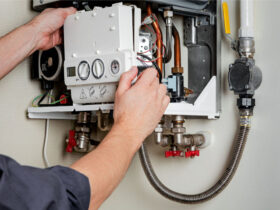When considering replacement windows and doors and the security benefits derived from the inherent use of both laminated and toughened glass; it is worthwhile noting the distinguishing features, overall variances and advantages between the former and the latter.
Toughened Glass
Often referred to as tempered glass, its application is commonplace across the globe. There are numerate uses for toughened glass and it can be typically found in car windscreens, glass partitions, glass door and oven doors.
The formation of toughened glass comes about through the application of heat treatment or thermal tempering to standard annealed glass.
Benefits
Ostensibly one of the key benefits to be derived from toughened glass is its innate strength, resulting in it being about four times stronger when compared with standard annealed glass. Moreover, the surface compression rate is such that it can easily withstand 10,000 lbs per square inch or 10,000 psi. Furthermore is its ability to withstand thermal breakage. Both of these factors have clear security implications when compared to standard annealed glass.
Conversely if toughened glass does happen to break, rather than shattering into dangerous shards akin with normal annealed glass; toughened glass crumbles homogeneously into smaller fragments. Clearly from an injury perspective this has understandable advantage connotations over annealed glass. And breaking uniformly into smaller fragments will result in it being easier to clear away afterwards without the resulting injury of larger shards typified with annealed glass.
And finally, being heat resistant and utilised in applications such as oven doors and able to withstand a direct flame; its uses does not have to be confined to the security market – but also cookware and laboratory equipment.
Laminated Glass
Essentially with laminated glass there is an interlayer of Polyvinyl Butyral or PVB as it is commonly referred to, placed between two layers of glass to improve its overall structural solidity. If broken, rather than shattering like a standard pane of glass, it remains intact but shatters into a pattern resembling that of a spider’s web. But with the interlayer in between the panes of glass this safeguards against entry until re-glazing can be undertaken.
Because of its innate ability to remain intact it provides a security deterrent as it is difficult to smash. It is able to withstand constant strikes of a cricket bat before the surface is compromised, therefore providing adequate resistance to a Burglars intrusion.
Due to the escalating crime rate the use of laminated glass permits the occupants to live safely and enjoy the views without compromising safety. It is so useful that it can be adapted for use in Prisons and able to withstand bullets if the layer is suitably thick enough. Moreover, depending upon your preference laminated glass can be adapted and made several sheets thick.
Protection from the elements
If broken laminated glass effectively remains intact and maintains the building envelope until such time as it needs re-glazing. Thus as opposed to normal annealed glass that would shatter and allow the prevailing weather elements to penetrate the building’s natural integrity, with ensuing flying debris and resulting further damage; laminated glass remains intact and does not falter.
Designer Glass
If you are desirous for tinted glass or increased opacity then DuPont has the answer, and are readily able to offer tints and reflective glass laminate interlayers. So the design and integrity of your building does not have to be compromised for the sake of increased security.
Regardless of which option is more favourable – toughened or laminated glass, both have clear and definitive benefits, and both can easily be distinguished between by looking for the kite mark and following corresponding British Standard codes found in the corner of the glass:
Laminated – BS EN 14449
Toughened – BS EN 12150





